Ever wondered how to do baby led weaning? Look no further – the Ultimate Baby Led Weaning Guide is here! Learn baby led weaning tips, benefits, first foods, videos and more.
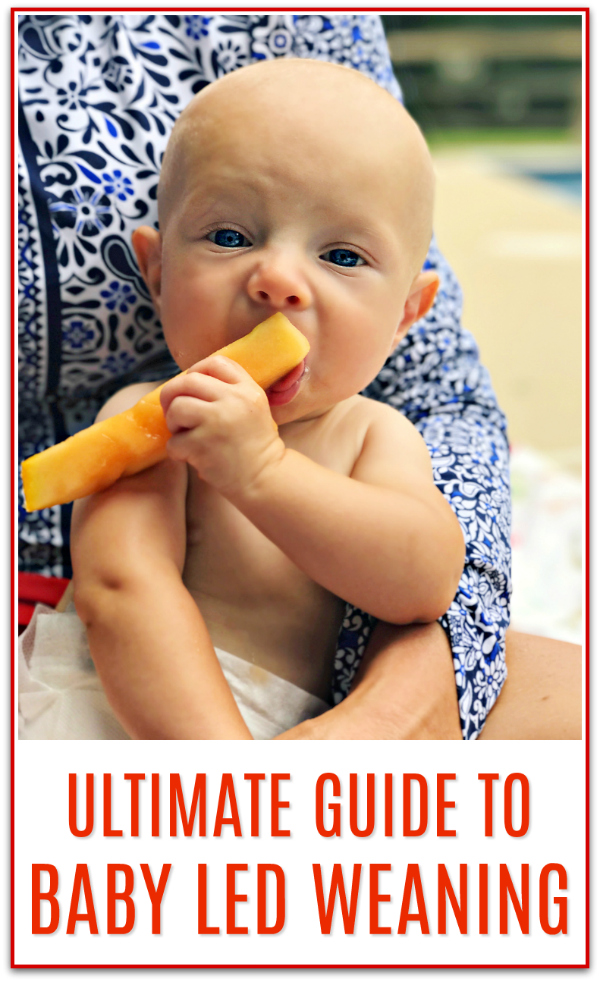
Ultimate Baby Led Weaning Guide
Whenever we go out to eat, there’s at least one person who tells us how impressed they are with Sam’s eating. The last time we went out to dinner, he drew a group of about 15 people, including some of the restaurant workers, around him. They watched in amazement and curiosity as he happily ate a whole plate of food. “You’ve got to see this baby!” I heard one of the servers call to the cook in the back.
(I was actually the embarrassed one – Sam loved all the attention! ha!)
And I can certainly understand their amazement. He eats anything and everything – from salmon roe sushi, liver, buffalo chicken legs, spicy kimchi and bowlfuls of curry to a plate of broccoli, mushrooms, asparagus and avocado.
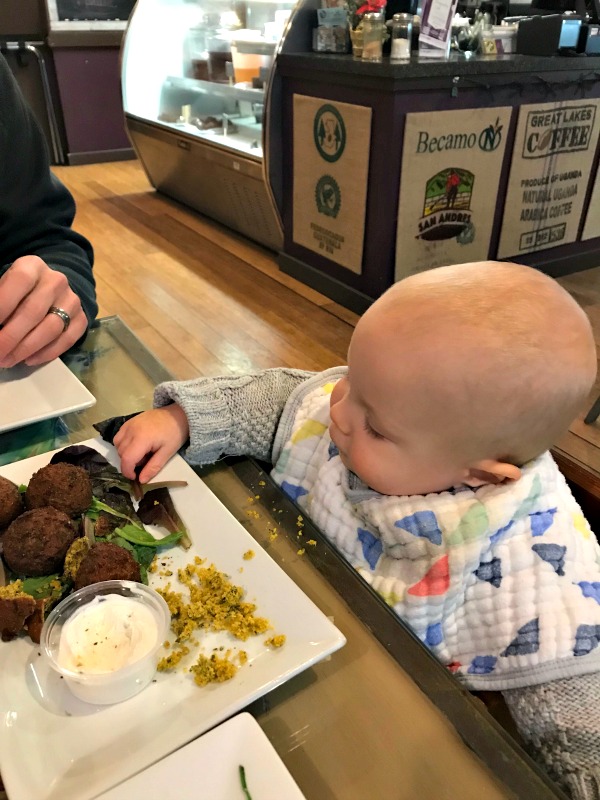
People watch in wonder and amazement and then ask, “how in the world did you get him to eat like that?”
To which I respond, “We’ve done baby-led weaning since he was 6 months old!”
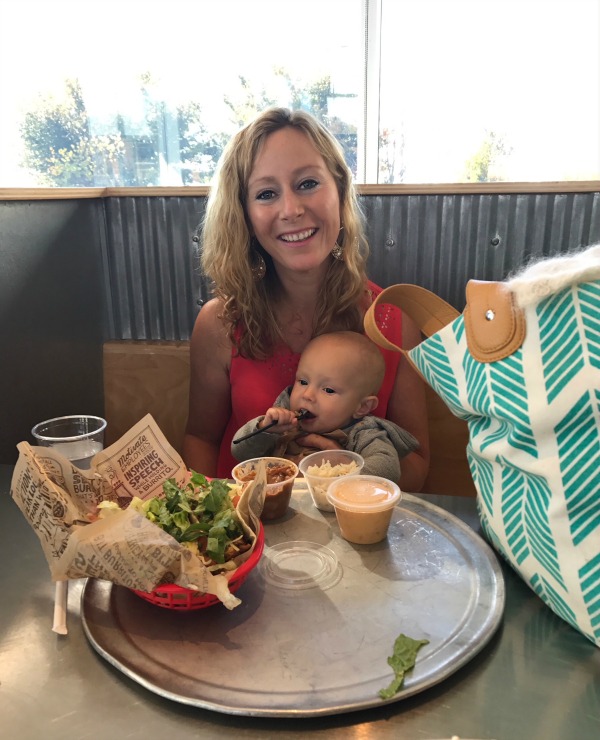
What is Baby Led Weaning?
Baby-led weaning is the choice to let our babies feed themselves, from about six months old on. This means that you let the baby reach for and handle foods themselves, making use of their grasping and holding skills.
Baby Led Weaning also means no baby food, no purees, no spoon feeding and certainly no force feeding! This is a big part of it—you have to trust the baby, let the baby handle real foods and try to eat them. Most people who practice this approach simply choose to give the baby some of what the family is eating, which is what we do. Sam eats what we eat!
It’s important to note that this doesn’t mean you cut the baby off from breast milk or formula. Far from it! Your baby is still learning how to feed themselves in the beginning and likely won’t get it right for a long time. Keep using breast milk or formula as your baby’s main source of food while they learn and explore different foods. I like the saying, “food before one is just for fun.”

We’ve practiced baby led weaning with Sam since he’s been about 6 months old. It’s been fantastic for us and it’s something I’d definitely recommend to anyone interested. Here’s why:
The benefits of Baby Led Weaning:
Adventurous eaters
I personally agree with other baby led weaning advocates that say this approach can help children become less picky eaters. All of the moms I’ve talked with about baby led weaning agree. They said, hands down, their kids who’ve done baby led weaning are much more adventurous eaters compared to their kids who were fed pureed baby food.
Research shows that the more variety offered early on, the more readily they will try things later. All babies are exposed to different tastes and flavors in the womb. Babies enjoy flavors, even strong or spicy ones! Imagine my surprise, when Sam grabbed a very spicy chicken leg and absolutely loved it! Babies first foods do not have to be bland – in fact, the wider range of flavors, the more adventurous eaters later in life. A wide variety of herbs and spices ensures more vitamins and minerals, too!
Healthier Eaters
I’ve also read many stories about people reporting babies grow up to be healthier eaters later on because of baby-led weaning. Babies who are exposed to a variety of healthy, nutrient dense foods early in life seem to acquire a preference for healthy foods. They intuitively know what’s good for their bodies!
Showing Trust in Your Child
One of the most important aspects of baby led weaning is fully trusting your baby to know what he needs at mealtime. It’s much easier said than done, especially for a control freak like me! I had to learn to let go of any expectations and trust that Sam will eat exactly what his body needs.
There are mealtimes when he hardly eats anything. I trust.
There are mealtimes when he just eats fruit. I trust.
There are mealtimes when he just eats chicken. I trust.
There are mealtimes when he just wants to drink water. I trust.
There are mealtimes when he just eats a glob of coconut oil. I trust.
The bottom line is that I provide Sam with a plate of nutrient rich food and trust him to eat whatever and however much he needs (or not eat at all).
Joyful Mealtimes and No Power Struggles
One of my favorite aspects of baby led weaning and trusting your baby is that it takes all the stress out of mealtime! I know so many families where mealtimes are an all-out war zone. They try to force and bribe kids to eat and when it doesn’t happen, mealtime turns into a stressful, frustrating and very negative experience for everyone involved. That is not the experience I want to create around food for Sam. I want mealtime to be joyful, stress-free and a fun, positive experience.
If you fully trust your baby then there’s absolutely no need to encourage, coax, bribe or force feed. Your baby will eat exactly what he needs to eat or he may choose to not eat at all. Trust it. The benefits of this trust are vast and wonderful for both parent and child that go well beyond the dinner table. Plus, you’ll create an enjoyable and fun experience around mealtimes!
Learning to Listen to their Body
My trust in Sam also teaches him to trust and listen to his body. And wow, what a powerful gift that is, isn’t it?! Listening to his body and trusting his intuition are gifts that will serve him well for the rest of his life.
More connection
Baby led weaning leads to more togetherness between the baby and the rest of the family since baby is included in family mealtimes, eating the same foods. Letting them eat while the family is eating is a good way to help them learn table manners, how to use utensils and how to eat different foods.
Easier, Less Time Consuming and cheaper
These are an added bonus in my book! Since baby is most likely just going to eat what you’re eating, there’s no need to deal with making time consuming purees or buying expensive ready made baby foods. And since you aren’t spoon feeding baby separately, you can save time and enjoy meal times together!
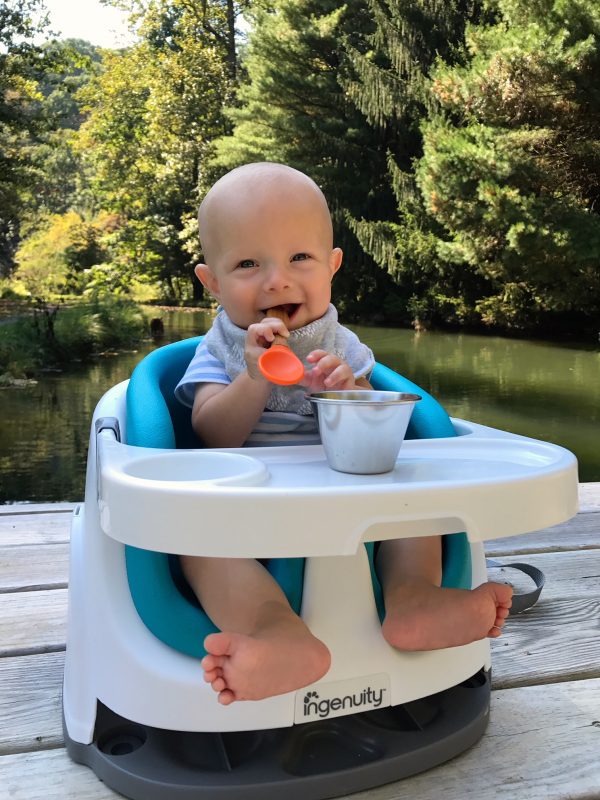
What about choking risks?
Choking is the first thing most people worry about when it comes to baby led weaning. And for good reason! At first, I was worried about choking, too.
But first, let’s clear up one thing: Choking rates are not higher in babies who were taught self-weaning. The one study that has taken this on so far, as imperfect as it was, did not show any links between baby-led weaning and choking. In fact, the babies who choked the most were those who had had the least experience with finger foods.
There’s a big difference between actual choking and gagging.
Gagging and Baby Led Weaning
Gagging is a protective mechanism that pushes the food away from the airway if it is too big to be swallowed. A baby’s gag reflex is very heightened and located near the front of the tongue so they will start to gag way before anything even gets close to the back of their throat. The baby may even vomit a little while gagging. Gagging can happen quite a bit while your baby learns how to manage food safely. It can be scary to watch, but it is a good thing because it means they are working it out. If your baby is gagging, it is crucial that you let them do their job. Do NOT interfere with a gagging baby – interfering can lead to choking.
Sam gagged a lot the first week of baby led weaning and it was so scary for me – almost scary enough for me to quit because I was so afraid he was going to choke! But he truly wasn’t even phased by it! Keep in mind, that gagging is a very good thing – the baby is learning how to manage food – and that actual choking is quite rare when the baby is in control of the food.
Choking
With choking, the baby will be silent and unable to make any noises. If a baby is silent and turning blue, they absolutely need help to dislodge the blockage. You can learn how to do infant back blows and chest thrusts correctly from Red Cross Babies HERE.
To minimize the rare chance of actual choking, you just have to prepare the food you give to the baby, especially in the very early weeks of baby led weaning. Cook those veggies until they’re squishy! Cut those cherry tomatoes and grapes into smaller pieces. And remember to NOT interfere with a gagging baby.
How to do Baby Led Weaning
First of all, start your baby off on solid foods when they start to show an interest in food or when they’re about six months old.
They need to be able to do a few things before they can properly handle solid food:
- Sit upright without help
- Hold their head up
- Hold their neck up (yes, it is different!)
- Shows an interest in food or grabs things off your plate
They also need to grow out of the tongue-thrust thing babies do when they’re nursing or drinking from a bottle. Think of how thumb-sucking works. Your baby has to be able to put their lips around food and swallow independently. That’s it!
Baby Led Weaning Tips for Baby’s First Foods:
As for starting, there really aren’t any rules, but there are some key tips that will make it a fun experience rather than a frustrating one. The most important thing you can do is offer foods that are easiest and safest to handle. Here’s how to do that:
- Cut food into “sticks.” Two inches in length is the ideal length for a baby to grasp well. They need to be able to close their hand around a piece of food to eat it in the early months.
- Food shouldn’t be too soft or it will turn to mush.
- Food shouldn’t be too hard or baby won’t be able to gnaw it.
Keep in mind: Baby led weaning can be very messy. They need to be able to “play” with their food, because that’s precisely how they’re going to learn how to handle it. You’ll be cleaning up after your baby for a long time! And high fives to all the parents who embrace the mess – it’s not always easy, but for me, the benefits far outweigh the mess 🙂
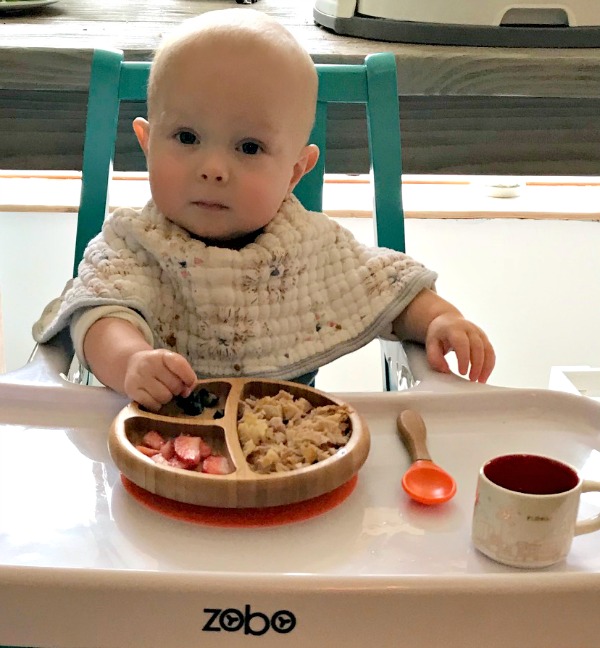
Healthy First Foods for Baby Led Weaning
Bananas and avocado are typically favorite first foods for baby led weaning. But really, you can use any foods that can be squished against the roof of the mouth. And there’s no reason your baby can’t share your food.
I strive to offer a protein, a source of healthy fat, a carbohydrate and water at every meal. He can then pick and choose what and how much to eat.
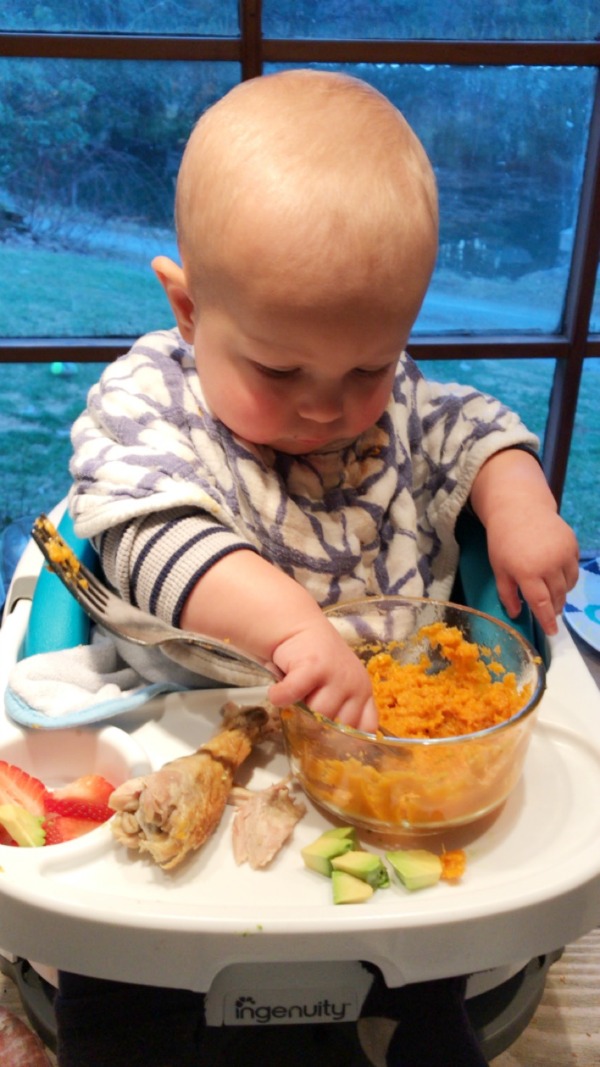
The following foods are the easiest for a baby to handle during the first weeks of baby led weaning:
-
- Fresh fruit cut into sticks or wedges
- Steamed broccoli or cauliflower
- Raw sticks of cucumber
- Meatballs
- Sticks of firm cheese
- Avocados cut into thick strips
- Sweet potato fries
- Thin strips of meat
- Scrambled eggs
- Flaky fish
Once baby’s skills develop, you’ll see that they can handle smaller foods and more awkward shapes. By the time Sam was 9-months old, it was rare for me to cut or prepare anything differently for him. He just eats what we eat in the same manner we eat it.
Baby Led Weaning Video Examples of Baby Eating
Here’s a video I made about our journey with Baby Led Weaning! It includes short video clips of Sam eating from 6 months old all the way up to 1 year old. See him eat salmon roe sushi, drink bone broth out of a mug all by himself, manage a whole chicken leg and more! If you aren’t used to seeing babies eat like this, I think you’ll be pretty impressed with my little guy (proud mama!). Enjoy!
Are you planning to practice baby-led weaning? What first foods have you given your baby? Tell me in the comments!
Pin the Baby Led Weaning Ultimate Guide HERE:

 Primally Inspired Real food, Natural Remedies, Holistic Living
Primally Inspired Real food, Natural Remedies, Holistic Living









This Baby Led Weaning is so cool! Wish people had known about it a long time ago because I know a LOT of very picky adult eaters. I’m going to give your info to a cousin and a friend, both of whom are expecting babies within the next few months – I think they might be open to it and maybe they would join your email list too.
Congratulations on your beautiful (and very cute) baby boy! You both look so happy and healthy together and I wish you both and your husband a lot of fun times together!
Thank you so much, Ines!!
So cute Baby.
Thank you, Anna!! 🙂
Thanks so much for the info and especially the videos. It has helped me and given me the confidence to carry with BLW.
One question – my boy is now 7 months, how much food do I give him? Do I keep putting sticks of food on his plate till he stops?
I do occasionally feed him with a spoon when it’s going to be really messy, like oats. What did you find was the best way to teach him to use a spoon himself? (okay, maybe two questions 🙂
Thanks so much!
Hi Annelize! I put more on the plate until he stops or lets me know he’s done.
I still occasionally feed Sam with a spoon and he’s almost 2 haha! Sometimes it’s just easier that way and you do what you have to do in certain circumstances, right?! He’s pretty great with a spoon, but when we go out to eat and the food is really messy, I definitely help him just to make it easier and less mess for me. I also helped him with soup and really messy things like that until he could properly work a spoon.
The best way for them to learn is just through practice. As often as I could tolerate, I let him practice even when it would be messy. The days I couldn’t handle the mess, I just fed him myself and that’s perfectly okay. I let Sam play with a spoon and cup during his bath time and looking back, I think that really helped his skills a lot! 7 months is still really, really young to actually work a spoon and it likely won’t be many months down the road until he can manage one well – the majority of kids in our 18 month old – 2 year old parent/child program still can’t eat well with a spoon. But it sounds like your guy is getting a great start and has a great mom to support him!
Hope that helps! Take care!!!
Hey Kelly, I’m so glad I came across your blogs when I was looking for the benefits of collagen peptides. I love this baby led weaning post so much because my daughter is currently 4 months and is exclusively breastfed so I was wondering how to go about weaning her in the next two months. I will indeed continue breastfeeding up to a year but I wanted an idea of how to introduce her to new foods.
Question : when did you start giving Sam water?
Hi Keisha! I’m so glad you found this right when you needed it 🙂
I started offering Sam water when I started baby led weaning at 6 months, but I would only offer him a very small amount of water (about 1/4 cup) and only after he was all done trying/eating/playing with his food. In the early months of baby led weaning, water was definitely more for practice drinking out of a cup than actual thirst. He didn’t really become interested in drinking much more than that or drinking it for thirst until he was much older – probably around 10-12 months if I remember correctly. We were still nursing a ton at that point so I’m sure it would be different for others who stopped nursing. I still offered it after every meal just in case and always followed his lead if he ever asked for more.
Blessings to you and your little one!
Hi dear, I am so struggle with my baby’s food. He is now 10 month old and suddenly refused puree feed by me. I believe it happened after I introduced some puff sticks which I bought. Now he wants to eat which he can chew. So I introduced fruits and veggies, but he reduced. He only like vegi or chicken cutlet. That is also very small amount. I feel that he is not getting enough food. Please help me to solve this problem.
Hi Dul, it is difficult as a parent to feel like your baby isn’t eating enough! There were and still are days I feel this way, too. I have to work really hard at letting go of that control and trusting my baby some days. That can be so hard!
But I try to remember that babies are so smart and truly do know how much they need to eat even when it feels to us that they should be eating more. Also, when they are teething or sick, it’s very common for them to not eat much at all. As long as you are offering a variety of food for your baby (and still feeding breast milk or formula at 10 months), it really is best to trust the baby to eat how much and what even if it’s a very small amount and/or they choose not to eat a lot of variety for now. They still should be getting the majority of their nutrition from breast milk or formula at this age.
And just because they don’t like certain foods right now, it doesn’t mean that they will never like them. Sometimes they will refuse a food day after day and then a week or a month later, love that same food! I wish you and your baby the best.
Thank you for this blog and video! I hope to start BLW soon with my son and I just have a few questions:
How long before/after breastfeeding would I give him solids? And how do I know when to add more meals throughout the day?
How did you go about introducing new foods while watching for allergies? When/how should I introduce allergens (peanuts, shellfish, etc)?
You baby boy is adorable! I hope my son will be as good an eater as yours is!
Hi Ruby! So happy to get your kind comment! To answer your questions….
I would have a breastfeeding session a half hour to an hour before our meals to ensure he was still getting the bulk of his nutrition from breastfeeding.
Before 1, we did baby led weaning at every meal (breakfast, lunch and dinner) as long as he was interested.
The current research now says the earlier the better when introducing allergens and you definitely want to introduce allergens before 1. We did start to introduce allergens as soon as he started eating solid foods at 6 months and thankfully, he has no allergies.
Best practices say to introduce a teaspoon of an allergen over the course of 3 feedings. You want to give them a small taste and then wait 10 minutes. If there is no allergic response, give your baby the rest of the teaspoon. Keep an eye on the baby for the next 2 hours to ensure no allergic response. Then repeat that process for 2 more feedings if there is no allergic response. I waited a week or so before introducing another allergen.
Once we were sure there were no reactions, we just continue to eat the allergens as regular food.
Also, if you eat peanuts, shellfish and other allergens and you breastfeed (or even ate them while pregnant), you have already exposed your baby to allergens, which is a great thing and it’s much less likely they will have an allergic reaction now.
I hope this answered your questions – if not, let me know! I wish you and your baby the best!!! 🙂
My baby seems to be interested in our food only to the point of grabbing to play with the food while excessively drooling but never actually putting it in his mouth. He is a few days away from being 6 m/o. Does this mean he isn’t ready for solids?
Also, when you started BLW did you follow the “3 day rule” before introducing a new food item?
Hi Judy,
I would just let him play with the food as long as he wants. Playing with it and being curious about it is really good for him even if he doesn’t eat it or taste it yet. He’ll taste it when he’s ready 🙂
Personally, I followed the 3 day rule for allergens only.